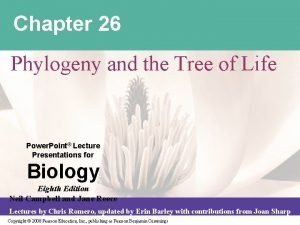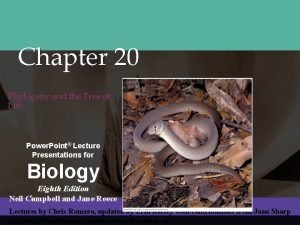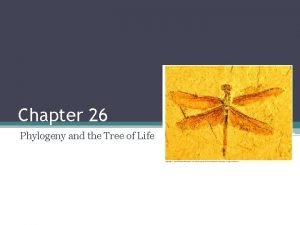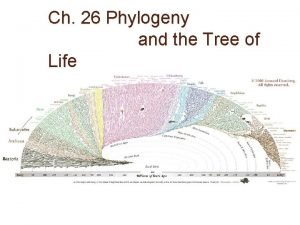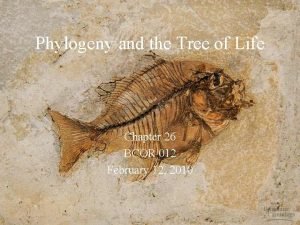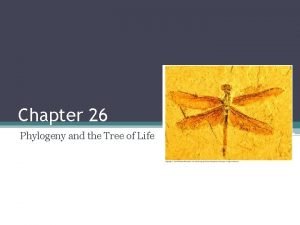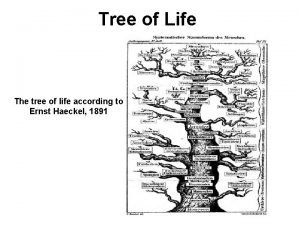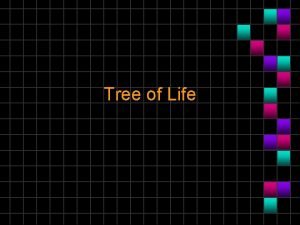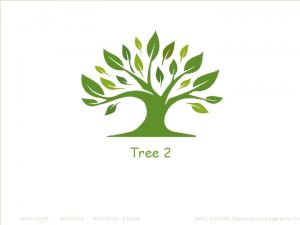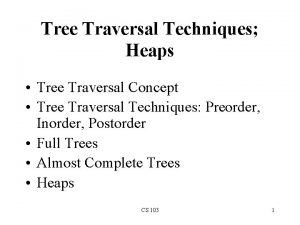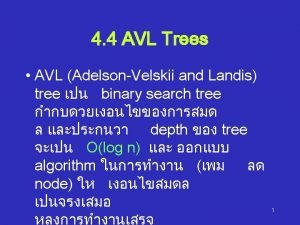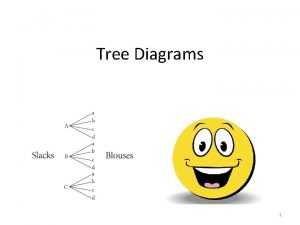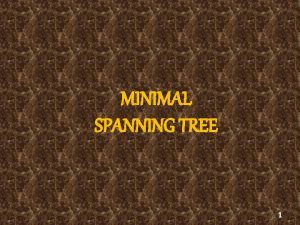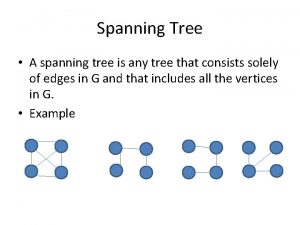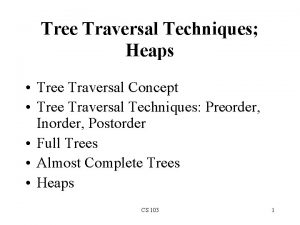Chapter 26 The Tree of Life The Tree









































- Slides: 41

Chapter 26 “The Tree of Life” “ The Tree of Life”

“origins of life” • 1. 2. 3. 4. Scientific evidence points to 4 sequential stages that led to the first life forms: the abiotic synthesis of small, organic molecules. The synthesis of polymers from these molecules. The creation of “protobionts”. The origin of self replicating molecules.

Aleksandr Oparin (1924) • Suggested that if the primitive atmosphere was reducing (as opposed to oxygen-rich), with an appropriate supply of energy, then a wide range of organic compounds might be synthesized. • Suggested that the organic compounds could have undergone a series of reactions leading to more and more complex molecules.

• He proposed that the molecules formed colloid aggregates, or 'coacervates', in an aqueous environment. The coacervates were able to absorb and assimilate organic compounds from the environment in a way reminiscent of metabolism. They would have taken part in evolutionary processes, eventually leading to the first life forms.

John Haldane (1929) • Haldane's ideas about the origin of life were very similar to Oparin's. Haldane proposed that the primordial sea served as a vast chemical laboratory powered by solar energy. The atmosphere was oxygen free, and the combination of carbon dioxide, ammonia and ultraviolet radiation gave rise to a host of organic compounds.

• The sea became a 'hot dilute soup' containing large populations of organic monomers and polymers. • groups of monomers and polymers acquired lipid membranes, and that further developments eventually led to the first living cells. • Coined as the “primordial soup” theory.

Stanley Miller • A chemical experiment that simulated the conditions thought at the time to be present on the early Earth (Oparin-Haldane hypothesis). • After Miller's death in 2007, scientists examining sealed vials preserved from the original experiments were able to show that there were actually more than 20 different amino acids produced in Miller's original experiments. There is abundant evidence of major volcanic eruptions 4 billion years ago, which would have released (CO 2), (N 2), (H 2 S), and (SO 2) into the atmosphere.



Macros and the Prebiotic Soup • Chemical evolution theory predicts the first living entity was a self-replicating molecule. – Arguments in favor of proteins as the first living entities: • Prebiotic soup likely contained many different proteins due to polymerization from amino acids on mineral surfaces. • Proteins are the most efficient catalysts known-A self-replicating molecule must act as a catalyst to assemble and polymerize its copy.

– Arguments against proteins as the first living entities: • Assembly of a copy requires a template that provides the pattern/instructions for assembly. • Proteins can be catalysts, but cannot act as templates for synthesizing new proteins. • Conclusion: Proteins were most likely not the first living entity

DNA and the Prebiotic Soup • Lack of chemical reactivity means that DNA is not an effective catalyst. • In a living organism, no DNA molecule has ever been shown to have catalytic properties. • Conclusion: DNA was most likely not the first living entity •

RNA and the Prebiotic Soup • RNA can act as a template, but is not as good a template as DNA. • RNA can act as a catalyst, but is not as good a catalyst as proteins. • Only RNA can act as both template and catalyst. • Conclusion: RNA was most likely the first dominant life form prior to the formation of the cell “RNA World Hypothesis” (Gilbert 1986)

• In 2001, the RNA world hypothesis was given a major boost with the deciphering of the 3 -dimensional structure of the ribosome, which revealed that at the key catalytic sites, the ribosome was composed of RNA, with proteins playing only a structural role in holding the ribosomal RNA together. • Specifically, peptide formation is catalyzed solely by RNA. This finding suggests that RNA molecules were responsible for generating the first proteins.

So… • A self-replicating RNA molecule appears in the prebiotic soup as the result of chemical evolution. • The self-replicating RNA makes copies of itself using free ribonucleotides in the prebiotic soup. • The RNA cannot match up complementary ribonucleotides to its template perfectly. • Many inexact copies (mutations) are made randomly, which produces diversity in the population of self-replicating RNAs.

• Natural selection occurs. Mutants that are more efficient self-replicators produce more copies of themselves, dominating the population. • Less efficient self-replicators may be destroyed by UV radiation or a chemical reaction before they can copy themselves. • Evolution results - changes in the composition of the population over time. • Chemical evolution gives way to biological evolution over time.

Results of Miller and Urey experiment – ü (CH 4) converted into compounds of (CH 2 O) and (HCN) which then combined to form simpler molecules such as (HCOOH) and (N 2 HCONH 2). ü Some complex amino acids were also found ü In similar experiments performed later, more than 30 different compounds were identified.

Life – • Requires a way to obtain, store and extract an energy source. • Requires a membrane to maintain homeostasis and isolation of molecules from the environment causing their concentration. • Eukaryotic cells, sexual reproduction and mulitcellularity contribute to diversity.



Protobionts • Protobionts are systems of abiotically produced molecules surrounded by a membrane: ü self replicating/exhibit reproduction ü exhibit metabolism ü maintain stable internal environment ü Exhibit membrane excitability


RNA #1!!! • RNA must have been the first genetic material. • RNA that can carry out a number of catalytic functions Ribozyme • Ribozymes can: ü make complementary copies of short pieces of RNA, given nucleotide building blocks. ü Splice ü Can take on a variety of shapes ü Can replicate




• Early protobionts must have used molecules from the environment for their growth and replication Heterotrophs • Scientific evidence suggests that early life possessed a simple electron transport mechanism. • Evolved during a time when there was no oxygen and before photosynthesis. • Needed energy-rich supply such as hydrogen, methane and hydrogen sulfide.

Evolution of Oxygen • Photosynthesis probably evolved prior to photolysis. • Cyanobacteria are the only living prokaryotic, oxygen liberating autotrophs. • Oxygen liberating autotrophs evolved after. • Free oxygen dissolved into surrounding waters and reacted with dissolved iron producing iron oxides.


• As oxygen concentration increases, chemical bonds are attacked, enzymes inhibited and cells damaged. • prokaryotes that survived did so in an anaerobic environment. • Some survivors possess adaptations to the increasing oxygen including cellular respiration.

Eukaryotic evolution • Complexity increases with the evolution of eukaryotes. • The oldest agreed upon are 2. 1 billion years old yet some cholesterol molecules are traced back to 2. 7 billion years ago. • The formation of these molecules implies the origin to be around the same time as the “oxygen revolution”.

Endosymbiotic theory Prokaryotes lack: ü Internal structures ü Cytoskeleton to change shape(engulf) and shift organelles.

• Plastids and mitochondria are believed to have evolved from an endosymbiont theory • Mitochondria being aerobic heterotrophic prokaryotes. • Plastids being photosynthetic prokaryotes. • Involvement via undigested or internal parasites becoming mutually beneficial.


Evidence for theory 1. The internal membranes of chloro/mito have enzymes and transport systems that resemble those of living prokaryotes. 2. Replication thru binary fission. 3. Contain single, circular DNA not associated with histones. 4. Ribosomes of mito/chloro are most similar to those of the prokaryotic cells.

Multicellularity • Algae, plants fungi and animals are the decedents of multicelluar organisms. • Common ancestor date back to 1. 5 billion where as the oldest known fossil 1. 2 billion. • Colonial were the first multicellular organisms ie. Pediastrum • Cellular division and differentiation allowed the organism to divide particular life functions among specific groups of cells

Pediastrum

• The “Cambrian Explosion” saw an appearance in most of the major phyla of animals. • Many large animals appeared with hard shells and exoskeletons that fossilized easily. • The colonization of land was a pivotal milestone. • Continental drift is the major geographic factor that correlates with the spatial distribution on the planet.



 Phylogeny
Phylogeny Chapter 20 phylogeny and the tree of life
Chapter 20 phylogeny and the tree of life Monophyletic paraphyletic polyphyletic
Monophyletic paraphyletic polyphyletic Chapter 26 phylogeny and the tree of life
Chapter 26 phylogeny and the tree of life Phylogeny and the tree of life chapter 26
Phylogeny and the tree of life chapter 26 Chapter 26 phylogeny and the tree of life
Chapter 26 phylogeny and the tree of life Hát kết hợp bộ gõ cơ thể
Hát kết hợp bộ gõ cơ thể Bổ thể
Bổ thể Tỉ lệ cơ thể trẻ em
Tỉ lệ cơ thể trẻ em Chó sói
Chó sói Tư thế worm breton
Tư thế worm breton Chúa yêu trần thế alleluia
Chúa yêu trần thế alleluia Môn thể thao bắt đầu bằng từ đua
Môn thể thao bắt đầu bằng từ đua Thế nào là hệ số cao nhất
Thế nào là hệ số cao nhất Các châu lục và đại dương trên thế giới
Các châu lục và đại dương trên thế giới Công của trọng lực
Công của trọng lực Trời xanh đây là của chúng ta thể thơ
Trời xanh đây là của chúng ta thể thơ Cách giải mật thư tọa độ
Cách giải mật thư tọa độ Phép trừ bù
Phép trừ bù Phản ứng thế ankan
Phản ứng thế ankan Các châu lục và đại dương trên thế giới
Các châu lục và đại dương trên thế giới Thể thơ truyền thống
Thể thơ truyền thống Quá trình desamine hóa có thể tạo ra
Quá trình desamine hóa có thể tạo ra Một số thể thơ truyền thống
Một số thể thơ truyền thống Cái miệng bé xinh thế chỉ nói điều hay thôi
Cái miệng bé xinh thế chỉ nói điều hay thôi Vẽ hình chiếu vuông góc của vật thể sau
Vẽ hình chiếu vuông góc của vật thể sau Biện pháp chống mỏi cơ
Biện pháp chống mỏi cơ đặc điểm cơ thể của người tối cổ
đặc điểm cơ thể của người tối cổ Giọng cùng tên là
Giọng cùng tên là Vẽ hình chiếu đứng bằng cạnh của vật thể
Vẽ hình chiếu đứng bằng cạnh của vật thể Fecboak
Fecboak Thẻ vin
Thẻ vin đại từ thay thế
đại từ thay thế điện thế nghỉ
điện thế nghỉ Tư thế ngồi viết
Tư thế ngồi viết Diễn thế sinh thái là
Diễn thế sinh thái là Dạng đột biến một nhiễm là
Dạng đột biến một nhiễm là Các số nguyên tố
Các số nguyên tố Tư thế ngồi viết
Tư thế ngồi viết Lời thề hippocrates
Lời thề hippocrates Thiếu nhi thế giới liên hoan
Thiếu nhi thế giới liên hoan
